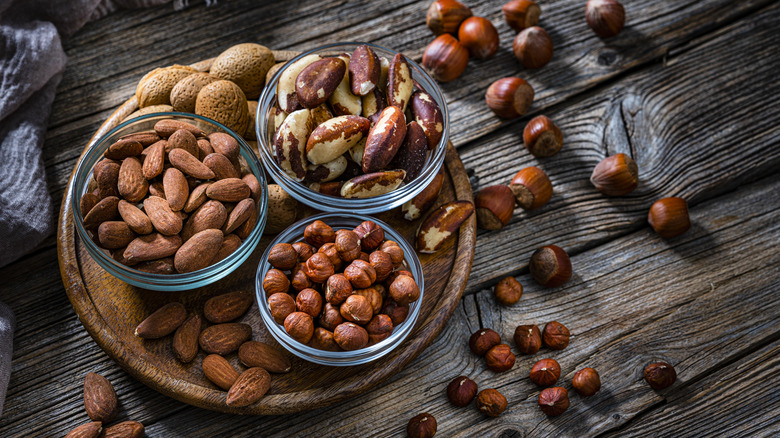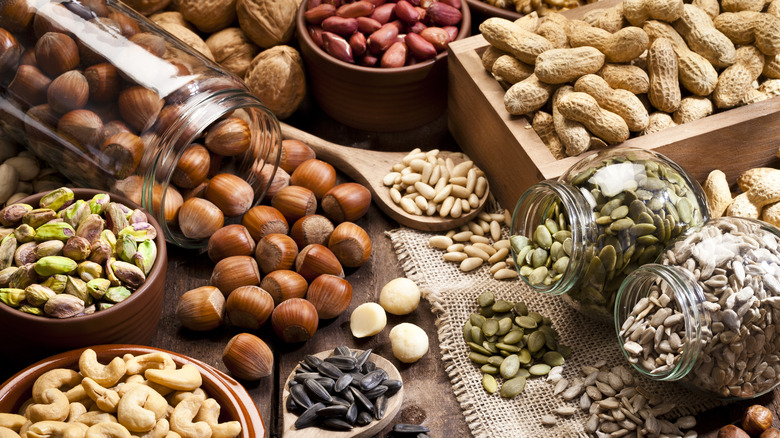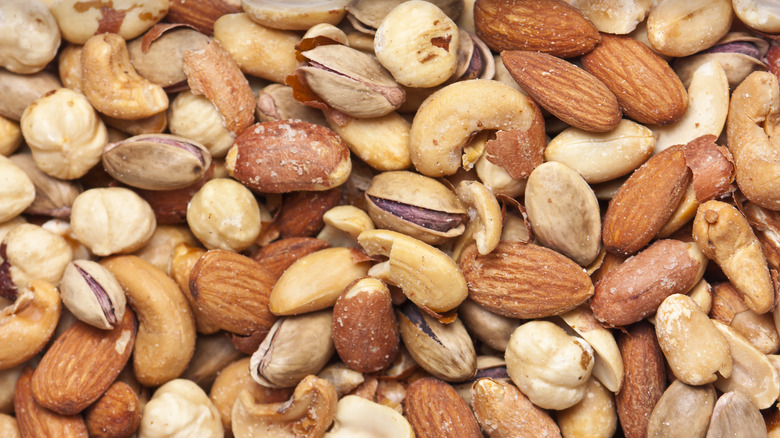In This Economy, Keep Your Pantry Nuts Frozen
With everyday essentials like milk, eggs, and proteins costing more now than they have in decades, inflation is wreaking havoc on many American households. But, if there's one thing that this economy has taught us all, it's the importance of stretching groceries as far as they can go and minimizing food waste. Pickling, fermenting, dehydrating, freeze-drying, and canning have become popular ways to preserve fresh produce to make them last longer, and where these methods fall short, a simple freezer can do the trick — particularly in the case of nuts.
Nuts don't tend to expire too quickly and, depending on the type, can have a shelf-life of three to nine months when stored at room temperature in a pantry. Whether or not they will stay fresh, however, is an entirely different story. Nuts are full of healthy fats, but the same oils that make them so nutritious can be what turns them rancid when not stored properly. When exposed to light, moisture, heat, and oxygen, these fats present can oxidize and leave a bad taste and aroma in place.
To prevent nuts from spoiling too soon, and extending their shelf-life, the best way to store them is to keep them in the freezer from the very day that you buy them. Frozen nuts like hazelnuts and Brazil nuts will stay fresh for at least a year doing so, whereas the likes of almonds, cashews, pecans, and walnuts will keep for up to two years. Pistachios will be preserved for three years!
How to freeze nuts to preserve them
Freezing nuts is actually pretty simple and straightforward. Because they don't fare well when exposed to heat, air, and moisture, it's important to store them in freezer-safe bags or airtight plastic and glass containers before putting them in the freezer. Another thing to keep in mind is that, while shelled nuts will take up more space and are more of a hassle, they are the best type to freeze. The shells naturally prevent exposure to outside elements and will keep them fresher for longer. Additionally, raw, whole, and unsalted nuts stay fresh for a longer period of time than chopped, cooked, or salted nuts.
It's also important to note that different nuts will have a different shelf-life when frozen. While the likes of cashews and almonds are more sturdy, others like hazelnuts have a shorter term. Pine nuts in particular have an especially short shelf-life of just six months, even when frozen. Because different nuts have different expiration times, it may be best to freeze each type separately rather than have them all mixed together in one container. Also, make sure to label each container with dates so you know when you stored them and have a rough estimate of how long the contents inside will last.
How to use frozen nuts
One of the biggest worries when it comes to freezing nuts is losing out on their hard and crunchy texture, since often, the cold temperatures of a freezer can make things become soft and soggy. It's not always the case, however. Toasted nuts that have been frozen in ziplock bags will retain the same crunch for at least a month when brought to room temperature. As long as you seal them tightly and give them time to thaw, frozen nuts will have a similar texture to those that are freshly toasted, giving off the same snap when bitten into.
While frozen nuts don't necessarily need any time to thaw, if they are going to be used in baking recipes where they will be heated as the dish cooks, you may need to thaw them first, especially if they are shelled — shells can be awfully tough to break when cold, so it's best to do so when they've warmed up a bit. Besides, if you'd like to eat them raw, giving the nuts time to come to room temperature will help get rid of that freezer-hard texture.
To do so, simply remove the nuts from their containers, spread them in a flat layer, and dry them properly to remove any excess moisture or condensation. Once they come to room temperature, you can use the frozen nuts as you normally would — chop them over bowls of yogurt, make a batch of simple spiced nuts, add them to smoothies, or even turn them into baked granola!



